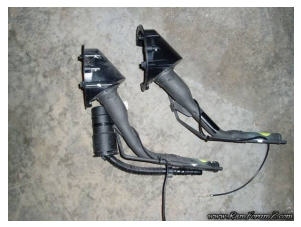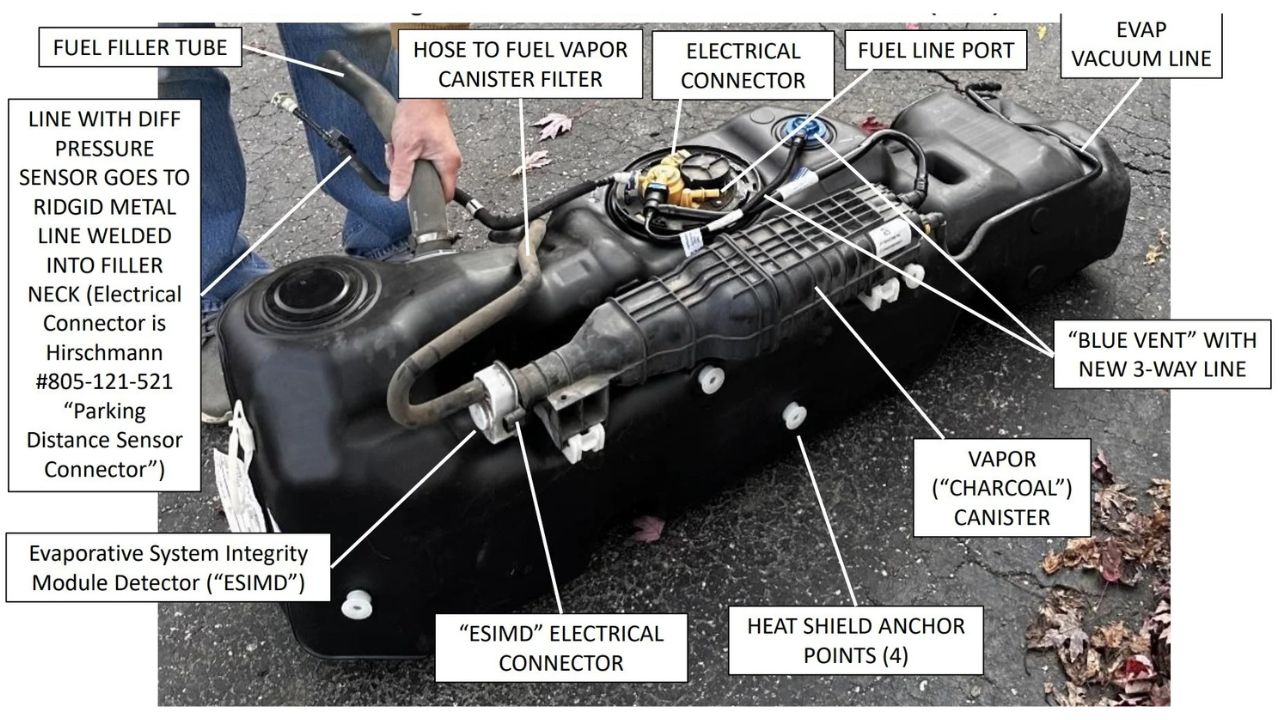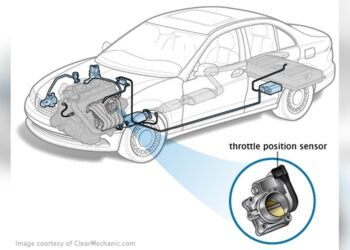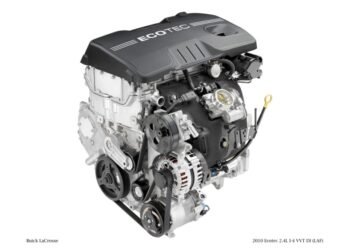Is your Ram 1500 giving you trouble at the pump? You’re not alone.
Fuel filler neck problems are a common headache for many Ram 1500 owners, and they can lead to frustrating issues like slow fueling, fuel leaks, or even that dreaded check engine light. But here’s the good news: understanding what’s going on can save you time, money, and a whole lot of stress.
In this post, we’ll break down the common fuel filler neck problems, how to spot them, and what you can do to fix them. Stick around—your truck (and your wallet) will thank you!
Common Symptoms Of Fuel Filler Neck Issues
Dealing with fuel filler neck problems on your Ram 1500 can be frustrating. These issues often creep up without warning, causing noticeable changes in your truck’s performance and behavior. Knowing the common symptoms can save you time, money, and headaches by addressing the problem early.
1. Difficulty Filling the TankOne of the first things you might notice is trouble at the pump. Does the fuel nozzle keep shutting off, even when the tank isn’t full? This could signal a clog or restriction in the fuel filler neck.
It’s not just an annoyance—it’s a sign something isn’t right. A blocked or damaged filler neck can disrupt airflow, making it hard for fuel to flow smoothly.
2. Strong Fuel Smell Around the TruckHave you caught a whiff of gas even when your truck isn’t running? A cracked or worn-out fuel filler neck could be the culprit. Fuel vapors escaping through leaks can create a strong smell around your Ram 1500.
This isn’t just unpleasant; it’s also a safety risk. Leaks increase the chance of fire and reduce your truck’s fuel efficiency.
3. Check Engine Light Turning OnYour truck’s check engine light can illuminate for a variety of reasons, but don’t overlook the fuel system. A malfunctioning fuel filler neck might trigger this warning. A common cause is a compromised seal, which messes with the EVAP (evaporative emissions) system.
If the light turns on after refueling, it’s worth investigating the filler neck. Ignoring it could lead to more expensive repairs down the line.
4. Fuel Leaks During or After RefuelingNotice a puddle of fuel under your truck after filling up? This is a clear indication of a damaged fuel filler neck. Cracks or holes in the neck can allow fuel to escape during refueling.
Keep an eye out for this issue—it’s not only wasteful but also hazardous. Addressing leaks quickly can prevent further damage to your truck and the environment.
5. Rust or Corrosion Around the Filler NeckTake a close look at your fuel filler neck. Is there visible rust or corrosion? Over time, exposure to moisture and road salt can eat away at the metal, causing structural weakness.
Even if it seems minor, corrosion can worsen rapidly, leading to cracks or leaks. Regular inspections can help you catch and fix this before it becomes a bigger problem.
Have you noticed any of these symptoms on your Ram 1500? Ignoring them could lead to more costly repairs or unsafe driving conditions. A little attention now can save you a lot of trouble later. What’s stopping you from giving your truck the care it deserves?

Credit: www.classaction.org
Causes Of Fuel Filler Neck Problems
The Ram 1500 is a reliable truck, but fuel filler neck problems can occur. Understanding the causes can help you address these issues effectively. Common causes include corrosion, physical damage, clogged vents, and manufacturing defects. Each has unique signs and solutions.
Corrosion And Rust
Corrosion is one of the top reasons for fuel filler neck problems. Exposure to moisture and road salt can lead to rust formation. Over time, rust weakens the metal, causing leaks or structural damage. Trucks in areas with harsh winters face higher risks of corrosion.
Physical Damage
Physical damage can occur due to accidents or improper handling. Dropping heavy objects on the fuel filler neck may cause dents. A damaged neck may not seal properly, leading to fuel leakage. Regular inspections can help spot physical damage early.
Clogged Vents Or Hoses
Clogged vents or hoses restrict airflow in the fuel system. Dirt, debris, or fuel residue can block these components. Blockages may cause slow fueling or pressure buildup. Cleaning vents and hoses can restore proper function and prevent further issues.
Manufacturing Defects
Defects during manufacturing can lead to premature fuel filler neck problems. Poor-quality materials or flawed designs may cause leaks or cracks. Vehicles with manufacturing defects may require part replacements. Identifying defects early ensures your truck operates safely.
Impact On Vehicle Performance
The fuel filler neck in your Ram 1500 might seem like a minor component, but when issues arise, the ripple effects can be significant. A faulty fuel filler neck doesn’t just inconvenience you—it can directly impact how your truck performs. Let’s break down the specific problems you might face and why they matter.
Fuel Leaks And Spillage
One of the most common signs of a bad fuel filler neck is fuel leakage. Imagine pulling up to the gas pump, filling up your tank, and noticing gas pooling underneath your truck. Not only does this waste money, but it’s also a serious safety hazard.
Leaking fuel can reduce your truck’s overall efficiency because your fuel isn’t being fully utilized. Worse, spilled gasoline can damage paint and harm the environment. If you’ve noticed strong gas smells near your vehicle, it’s time to inspect that filler neck.
Difficulty Refueling
Have you ever struggled to fill up your Ram 1500 because the pump keeps shutting off? A damaged or improperly venting fuel filler neck could be the culprit. This happens because the neck is designed to allow air to escape as fuel enters the tank.
When this function fails, refueling becomes frustratingly slow. You might find yourself holding the nozzle at odd angles, hoping to avoid constant interruptions. This simple task suddenly becomes a chore you dread.
Check Engine Light Activation
A faulty fuel filler neck can also trigger your truck’s check engine light. This usually happens when the neck fails to maintain proper pressure within the fuel system. Your vehicle’s onboard diagnostics system detects the issue and alerts you.
While the check engine light could mean many things, ignoring it isn’t an option. A damaged filler neck can lead to further complications, like reduced engine performance or poor fuel economy. If you’ve ruled out other causes, it’s worth inspecting the filler neck.
Have you experienced any of these issues with your Ram 1500? Addressing them early can save you time, money, and unnecessary stress down the road. Don’t let a small part compromise your truck’s performance.
Credit: www.promasterforum.com
Inspecting The Fuel Filler Neck
The fuel filler neck plays a crucial role in the Ram 1500. It ensures a proper seal while fueling and prevents leaks. Over time, this part may face wear or damage, leading to issues. Regular inspection helps identify problems early and prevents costly repairs.
Visual Inspection Tips
Start by parking your truck in a well-lit area. Remove the fuel cap and check the fuel filler neck for visible signs of rust. Look for any cracks, dents, or misalignment in the filler neck. A flashlight can help you spot hard-to-see areas. Ensure the filler neck sits securely and doesn’t wobble when touched.
Signs Of Wear Or Damage
Corrosion or rust is one of the most common signs of damage. Cracks or splits in the filler neck can cause fuel leaks. A loose or misaligned neck may lead to difficulties while fueling. If the fuel cap doesn’t seal properly, it could indicate filler neck issues. Watch for a fuel smell around the vehicle, as it may suggest a leak.
Diy Fixes For Minor Issues
Fixing minor fuel filler neck problems in your Ram 1500 can save you time and money. Many issues, like dirt buildup or small leaks, can be tackled with simple tools and a bit of patience. If you’ve noticed issues while refueling, try these DIY fixes before heading to a mechanic.
Cleaning The Filler Neck
Debris and grime inside the fuel filler neck can cause problems like slow refueling or difficulty inserting the nozzle. Start by inspecting the inside of the filler neck using a flashlight. You might be surprised by how much dirt can accumulate over time.
Use a soft, long-handled brush or a microfiber cloth to gently clean the inside. Avoid anything abrasive that could scratch the surface. If the grime is stubborn, add a small amount of rubbing alcohol to your cloth for extra cleaning power.
Once cleaned, use compressed air to blow out any remaining dust or particles. This step ensures the area is completely free of debris. Have you ever noticed smoother refueling after a deep clean? It’s a simple yet impactful fix.
Repairing Minor Leaks
Small leaks around the fuel filler neck can lead to fuel odors or wasted gas. To pinpoint the leak, inspect the area thoroughly for cracks or worn seals. Pay close attention to the rubber gasket between the neck and the tank.
If the gasket is worn, replace it with a new one. Gaskets are inexpensive and readily available at most auto parts stores. Ensure the replacement fits snugly to prevent future leaks.
For hairline cracks in the filler neck itself, use a fuel-resistant epoxy. Apply the epoxy carefully and let it cure according to the manufacturer’s instructions. Have you ever tackled a repair like this? It’s satisfying to know you fixed it yourself.
Taking a hands-on approach to small issues not only saves money but gives you a sense of accomplishment. Cleaning and repairing are straightforward tasks that anyone with basic tools can manage. Could this be your next weekend project?
When To Seek Professional Help
Not all Ram 1500 fuel filler neck problems can be fixed at home. Some issues require the expertise of a professional to ensure your truck stays safe and reliable. But how do you know when it’s time to call in an expert?
Severe Corrosion
Corrosion on the fuel filler neck isn’t just an eyesore—it can lead to serious performance and safety issues. If you notice deep rust, holes, or flaking metal, it’s time to act. A severely corroded neck can allow dirt and debris into your fuel system, potentially damaging your engine.
Take a moment to inspect the area around the fuel filler neck. If the rust seems to spread faster than expected, or if it looks like the structural integrity is compromised, don’t hesitate to consult a mechanic. Ignoring corrosion can result in costly repairs down the road, including fuel system contamination.
Persistent Fuel Leaks
If you’re smelling gas around your truck or spotting puddles under it, you might have a fuel filler neck leak. This isn’t just inconvenient—it’s dangerous. A fuel leak increases the risk of fire and reduces your truck’s efficiency.
Temporary fixes like tightening clamps or sealing small cracks might not hold up in the long run. If the leak persists despite your efforts, it’s time to let a professional diagnose the issue. They can determine if the filler neck needs replacement or if the problem lies deeper in the fuel system.
Are you noticing any of these signs in your Ram 1500? Don’t wait for the problem to escalate. Seeking professional help early can save you time, money, and frustration.
Preventing Future Problems
The Ram 1500 fuel filler neck is a critical component. It ensures safe and efficient fuel delivery to your vehicle. Neglecting its care can lead to costly issues down the road. Proper maintenance and protection can help extend its life and prevent future problems.
Regular Maintenance Tips
Inspect the fuel filler neck regularly for visible damage or leaks. Check for cracks, rust, or loose connections around the neck. Clean the area to remove dirt, debris, and fuel residue. Use a soft cloth and gentle cleaner to avoid damaging the material.
Schedule routine inspections with a trusted mechanic. They can identify potential problems early. Replace worn-out components promptly to avoid further damage.
Ensure the gas cap is sealed tightly after refueling. Loose caps can allow moisture and dirt into the filler neck. This can lead to contamination and corrosion.
Protecting Against Rust
Rust is a common issue for fuel filler necks. Moisture and dirt can accelerate corrosion. Apply a rust inhibitor to the filler neck to reduce this risk. Choose products specifically designed for automotive use.
Keep the area around the filler neck clean and dry. Wash off mud or salt buildup, especially after driving in winter. These substances can cause rust to form quickly.
Store your Ram 1500 in a dry location whenever possible. Avoid parking in areas with excessive humidity or standing water. This can help reduce exposure to moisture and prevent rust formation.
Cost Of Repairs And Replacements
Repairing or replacing a Ram 1500 fuel filler neck can be costly. Understanding the expenses involved helps plan for potential repairs. Costs vary depending on labor rates, parts, and vehicle condition.
Average Repair Costs
Repairing the fuel filler neck typically costs between $200 to $500. This range includes parts and labor charges. Replacement is usually more expensive than a simple repair. Labor costs make up a significant portion of the total expense.
OEM parts are often pricier but ensure better quality and fit. Aftermarket parts may reduce costs but could affect durability. Always weigh the options before choosing replacement parts.
Factors Affecting Expenses
Several factors impact the cost of repairing a fuel filler neck. The make and model of your Ram 1500 play a big role. Newer models often have more expensive replacement parts. Older trucks may require additional repairs due to wear and tear.
Labor rates vary by location and mechanic expertise. Urban areas generally have higher rates compared to rural regions. Mechanics with specialized skills may charge more but ensure quality work.
The extent of damage also influences repair costs. Minor leaks or cracks may only require simple fixes. Severe damage might necessitate a complete replacement, increasing the expense.
Whether you choose OEM or aftermarket parts affects the final bill. OEM parts are reliable but cost more. Aftermarket parts might save money but compromise quality in some cases.
Choosing Quality Replacement Parts
When your Ram 1500 fuel filler neck starts causing issues, finding the right replacement part is crucial. A poorly chosen part can lead to leaks, reduced fuel efficiency, or even engine problems. But how do you make the right choice? Let’s break it down step by step so you can make an informed decision.
Oem Vs Aftermarket Components
The first decision you’ll face is choosing between OEM (Original Equipment Manufacturer) and aftermarket components. OEM parts are designed by the same company that made your truck, ensuring a perfect fit and compatibility. However, they often come with a higher price tag.
Aftermarket parts, on the other hand, are made by third-party manufacturers. These can be more affordable and sometimes offer additional features. But not all aftermarket parts meet the same quality standards. Do your homework: read reviews, check warranties, and ensure the part meets your truck’s specifications.
Features To Look For
Not all fuel filler neck replacements are created equal. Look for corrosion-resistant materials, as this part is exposed to harsh elements like moisture and road salt. A rust-prone filler neck can lead to leaks and more frequent replacements.
Check for compatibility with your Ram 1500’s model year. Even minor differences in design can cause installation headaches or performance issues. If you’re unsure, consult your truck’s manual or ask an expert at the auto parts store.
Finally, prioritize ease of installation. Some parts come with pre-attached seals or clamps, saving you time and frustration during the replacement process. If you’re planning to DIY, this feature can make a big difference.
Have you ever been frustrated by a replacement part that didn’t last? Choosing quality replacement parts ensures you don’t face the same problem again. It’s worth spending a little extra time and money to get it right the first time.

Credit: vehicleprobes.com
Frequently Asked Questions
What Causes Fuel Filler Neck Problems In Ram 1500 Trucks?
Corrosion, wear, or damage can affect the fuel filler neck. Poor maintenance may also lead to issues.
How Do I Know If My Ram 1500 Has A Filler Neck Issue?
You might notice fuel leaks, difficulty refueling, or a check engine light related to the fuel system.
Can A Damaged Fuel Filler Neck Affect Engine Performance?
Yes, it can impact fuel delivery and cause engine misfires or reduced efficiency over time.
How Much Does It Cost To Replace A Ram 1500 Filler Neck?
Replacement costs vary but typically range from $100 to $300, including parts and labor.
Is It Safe To Drive With A Faulty Fuel Filler Neck?
Driving with a faulty filler neck can cause fuel leaks, posing safety risks. Repairing it quickly is recommended.
Conclusion
Dealing with Ram 1500 fuel filler neck problems can be frustrating. Identifying the issue early can save time and money. Regular inspections and proper maintenance help prevent complications. If the problem persists, consulting a trusted mechanic is essential. Addressing the issue promptly ensures better vehicle performance and safety.
Remember to check for signs like fuel leaks or trouble refueling. Staying proactive keeps your truck running smoothly. A little attention now can avoid bigger repairs later. Take care of your Ram 1500 and enjoy its reliable performance for years to come.















